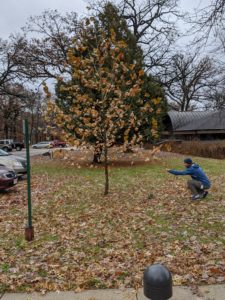 Bottom line – Don’t worry (too much)
Bottom line – Don’t worry (too much)
By Brian Wahl, DNR urban forestry coordinator, Fitchburg, Brian.Wahl@wisconsin.gov, 608-225-7943
Isn’t it time to LEAF? –Are our trees getting lazy and watching too much Netflix to be bothered with personal grooming? While this may be true for some tweens – something different is up with the trees. Normally, as part of the autumnal process, leaves begin to shut down the photosynthesis factories, shunt some final nutrients around, change colors and eventually fall to the earth (or my gutters). For a leaf to fall easily from a tree, it actively forms/grows/activates an abscission layer – essentially forming a weak layer between the leaf and the tree – a final clue to the leaf that it is time to “fly”.
This year, with our very early and unusually cold weather, some trees were caught off guard and didn’t get a chance to fully form those abscission layers. Keep in mind that some of our trees (some oaks for example), normally don’t drop their leaves until spring when the new buds start to swell. However, this year, I have seen silver maples, Norway maples, London plane trees, lindens, honey locusts, cotton woods and many other species still in nearly “full” but droopy leaf. In a normal year, this leaf retention into the winter would signal something is not quite right with the tree. Stressors like drought or root damage are commonly linked with leaf retention. In a normal year, those trees may or may not leaf out again next spring, depending on the nature and severity of the stressors.
So, what about this year? Does this mean I’m going to lose all those trees? No, (but….) the leaf retention related to the cold isn’t a red flag that a tree is in trouble. All else aside, it should leaf out and be a wonderfully happy little tree next year – Thanks Bob Ross. The issue of concern here is snow load. All those leaves still on the tree equals more surface area for snow and ice to cling. This extra snow can add a lot of weight pulling on branches. The sycamore in the photo was bent to 90 degrees after a recent snow fall, but it has bounced back wonderfully. My guess is that a healthy, structurally sound tree will likely go through winter similar to how it normally would, even though it may be carrying some extra weight this winter (who isn’t). I worry, though, about trees that aren’t so structurally sound – this will be an extra challenge and I would expect branch and some whole tree loss, under heavy snow or ice loads.
 Keep in mind that shaking a snow-burdened branch can cause it to snap. See this Arbor Day Foundation article for more information: Caring for Trees after a Heavy Snowfall. Prevention is the best medicine – young trees need “training pruning” so they can grow up to be structurally sound. Many older trees can also be pruned to be more storm resilient. Bottomline, a regular pruning program is essential to a storm resilient urban forest. For more information check out Trees and Ice Storms: second edition.
Keep in mind that shaking a snow-burdened branch can cause it to snap. See this Arbor Day Foundation article for more information: Caring for Trees after a Heavy Snowfall. Prevention is the best medicine – young trees need “training pruning” so they can grow up to be structurally sound. Many older trees can also be pruned to be more storm resilient. Bottomline, a regular pruning program is essential to a storm resilient urban forest. For more information check out Trees and Ice Storms: second edition.
My final suggestions – Don’t eat the yellow snow and don’t park under the silver maple with leaves this winter.
